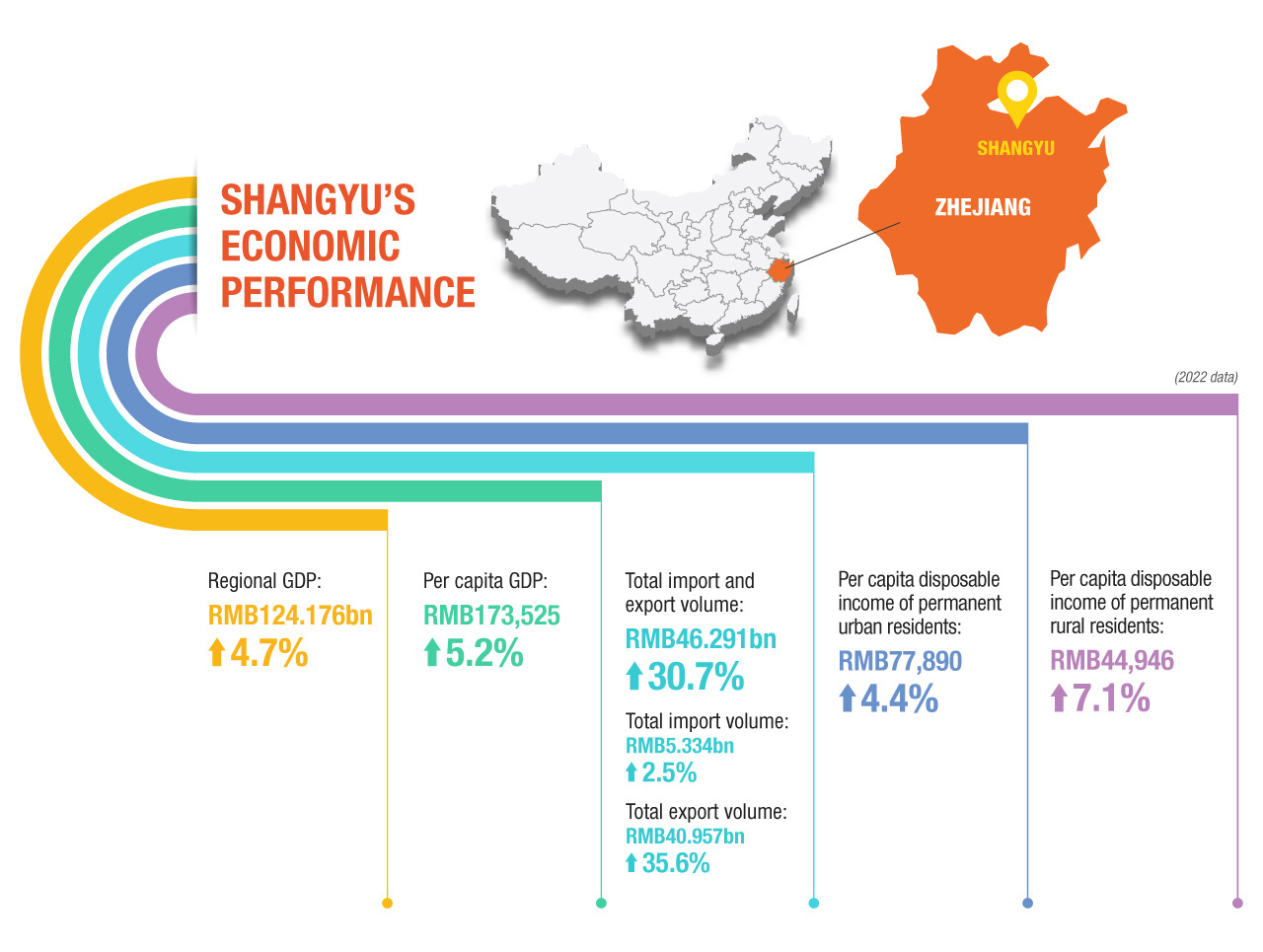A flourishing district of Shaoxing City located in the northeastern Zhejiang Province, Shangyu is a manufacturing hotspot for gifts and premiums, both nationally and internationally.
Situated in the southern part of the Yangtze River Delta and bounded on the north by Hangzhou Bay, Shangyu enjoys unique geographical advantages with Hangzhou, the provincial capital of Zhejiang Province, and Ningbo, a port city. Shangyu covers a total of 1,362 square kilometres and has a population of 840,000 people. The 2,200-year-old district, a flourishing part of northeastern Zhejiang Province, is where celadon pottery originated.With the Cao’e River flowing through the district and emptying into Hangzhou Bay, Shangyu is perfectly proportioned with mountains, rivers and plains. With its picturesque scenery and beautiful natural environment, Shangyu is named “National Garden City”, “Provincial Forest City”, “Provincial Eco-tourism Destination” and “Provincial Eco-tourism Demonstration Zone”, as well as on the list of “Top 100 Districts Embracing Green Development in the Country”. The district is pushing forward with industrialisation up north, where the National Hangzhou Bay Economic and Technological Development Zone is based, while forging ahead with urbanisation in the centre, with a developed area of 40 square kilometres and an urbanisation rate of 66.4 per cent. The south, which spans 800 square kilometres, is where the provincial-level Cao’e Tourist Resort is located, and is striving to create a national tourist resort and a national all-for-one tourism demonstration area.

Geographical advantages
Shangyu is fully connected by well-established transport networks on land and at sea including national expressways, high-speed rails, railways and canals. With the construction and reconstruction of national- and county-level expressways and high-speed rails coming into full force, Shangyu is now only one hour away from Shanghai and half an hour away from Hangzhou and Ningbo, forming the “same-city effect” with the three cities.Thriving economy and industries
In 2023, Shangyu’s GDP increased by 7.6 per cent. This propelled its comprehensive strength forward, placing it in the top 30 of the national comprehensive strength ranking for the first time at 29th position. Shangyu’s fine chemical and integrated circuit industries were chosen as a core area and a collaborative zone of the provincial characteristic industry clusters, respectively. Five enterprises were newly named national “little giants” with specialisation, sophistication, distinctiveness and innovation capabilities. Three enterprises were selected as part of the first batch of “eagle enterprises” of the province, in recognition of their leading roles in and impact on industrial or technical development, as well as their competitive strength. Shangyu won the Provincial Government Quality Management and Innovation Awards. It was also the only county (city, district) in Shaoxing City acknowledged as an outstanding entity in the Provincial Small and Micro Enterprises Three-year Growth Plan. Shangyu was among the first group of places to receive the “Zhejiang Manufacturing Tian Gong Ding”, an award for high-quality growth in the province’s manufacturing sector.In addition, Shangyu continued to enhance and expand its major platforms. For two consecutive years, the Hangzhou Bay Shangyu Economic and Technical Development Zone received a five-star rating as a provincial manufacturing industry demonstration zone. The “10,000 acres, RMB100bn” advanced polymer materials new industry platform was ranked seventh in the province and its comprehensive strength elevated it to the rank of the ninth national chemical industry park.
Well-planned urban development
There are two places in Shangyu that are best for production and living: the “One River, Two Banks” headquarters agglomeration area and “Future City”.The “One River, Two Banks” headquarters agglomeration area has a total length of 6.8 kilometres, a depth of 200 to 500 metres along the Cao’e River and an area of 12 square kilometres. Shangyu has commenced the construction of the North–South Central Avenue with an investment of RMB5.5bn, which connects the headquarters agglomeration area with the Hangzhou Bay Industrial Zone and the Jinbiandan Passage by the Cao’e River to promote the full implementation of the “manufactured in the north, headquartered in the centre” strategy. Today, the headquarters agglomeration area is home to a number of local leading enterprises and well-known domestic and foreign enterprises and institutions. It is said that having a headquarters in the area is a symbol of status and strength.
With a planned area of 15 square kilometres and a dedicated development office, “Future City” plans to attract scientific research institutes that have the capabilities to attract talent and funding, innovate and commercialise their inventions; it also plans to nurture emerging industries that will lead the future. “Future City” is the pioneer and model, as well as the lifeblood and vitality of “City of Youth”, a direction of development that Shangyu is moving towards.

Ideal business environment
Through establishing and offering a series of strategies, services and support to enterprises, Shangyu continues to carry forward the “pioneering spirit” displayed through setting up China’s first service centre that aims to provide convenience to the public. The district is committed to creating a highly efficient business environment with low start-up costs, a healthy innovation ecosystem and solid government leadership.Shangyu is also committed to transforming itself into a vibrant “City of Youth”, promoting the district’s high-quality development, competitiveness and modernisation, integrating itself into the construction of a high-level networked metropolis, forging ahead through high-quality development in five areas, rejuvenating the population and following the future city development model. With I&T and industries as the main drivers and various zones in the district as key platforms, Shangyu is developing itself into a young, modern, active, international, convenient, quality, digital and organised district. It is building an innovative, dynamic and open-minded “City of Youth” that is age- and eco-friendly, culturally inclusive and comfortable to live in. Shangyu endeavours to become the happiest place in China and continue to be on the path to Chinese-style modernisation and high-quality development.

